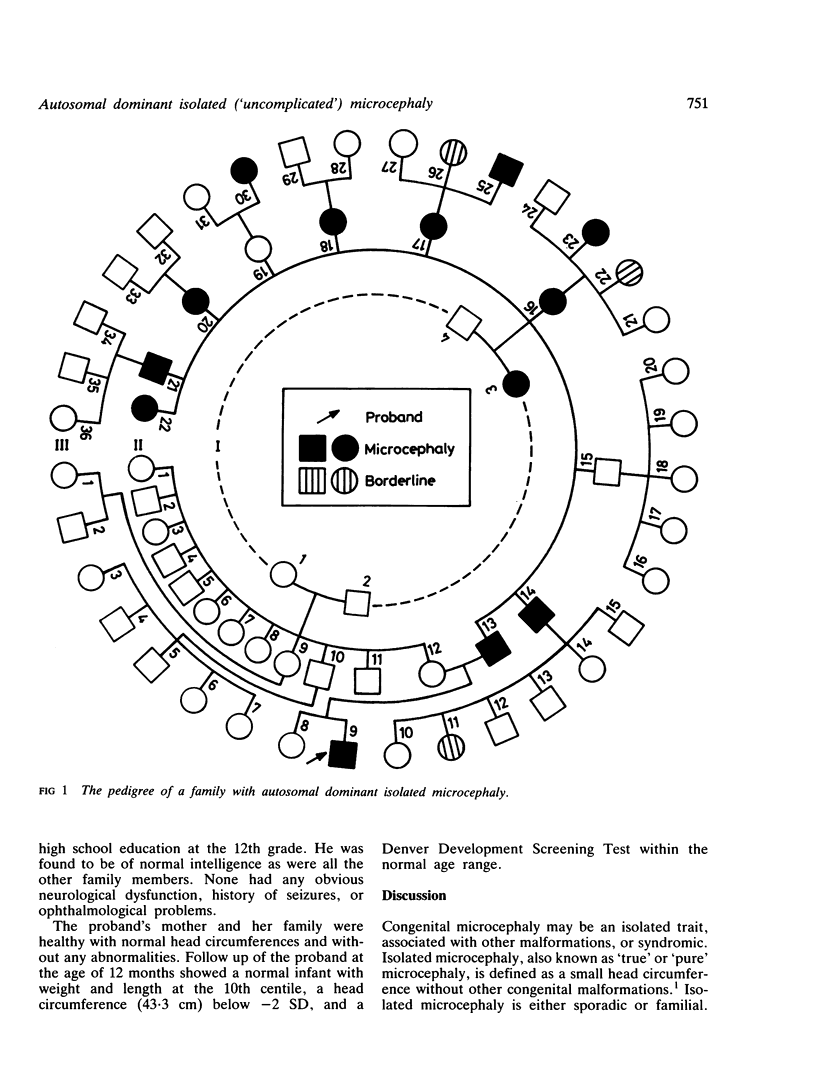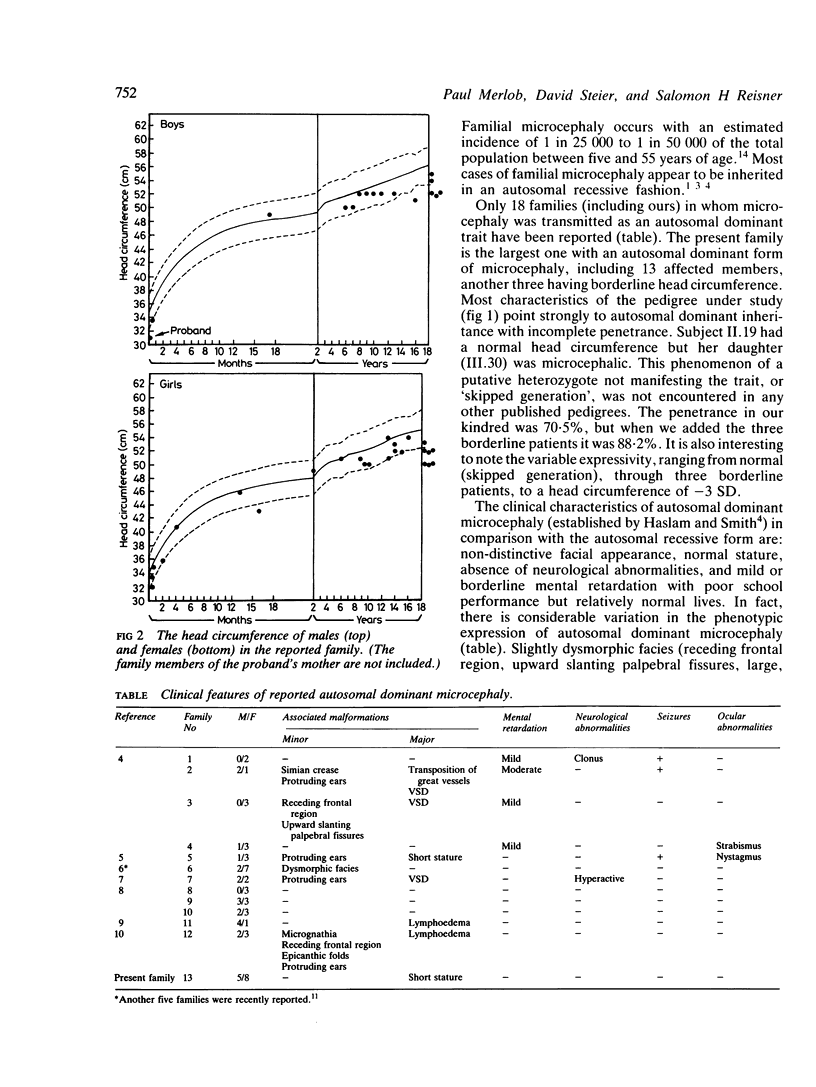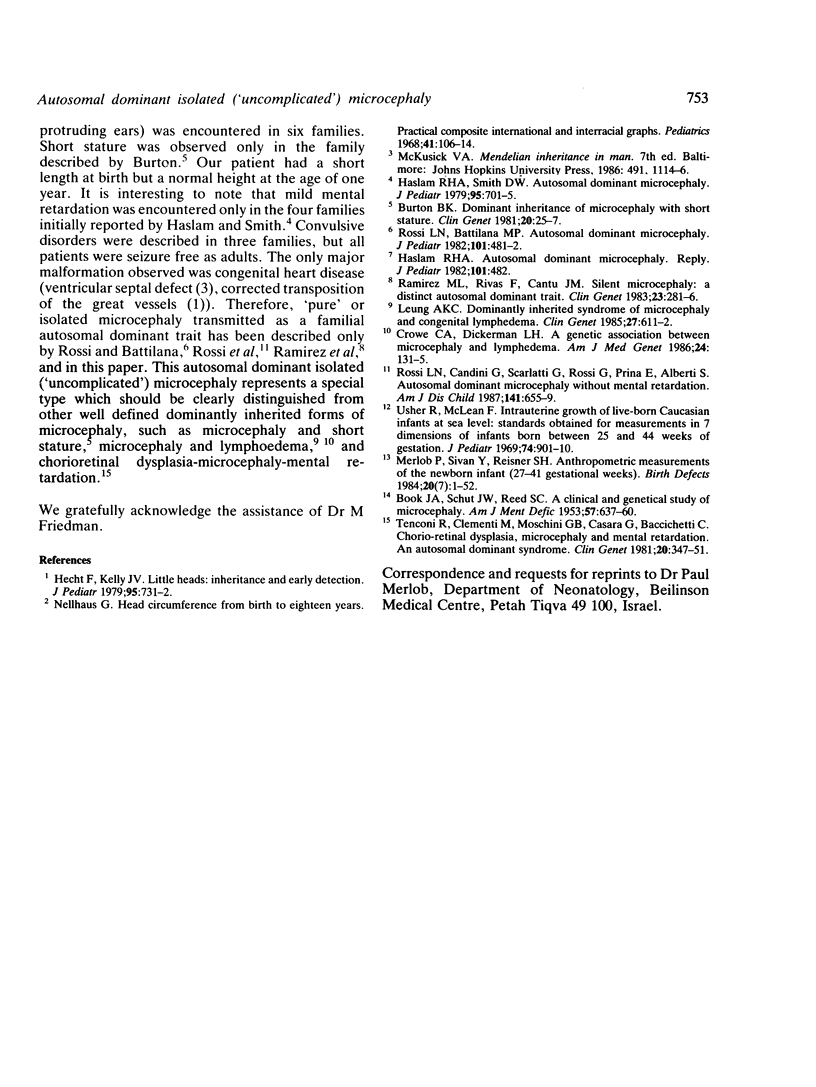Abstract
A large family (13 affected members in three generations) is reported in which isolated microcephaly occurred without any other dysmorphic or neurological abnormalities. The family pedigree confirms the autosomal dominant mode of inheritance with incomplete penetrance, including one example of male to male transmission and the occurrence of a non-manifesting heterozygote resulting in a 'skipped generation'. There is considerable variation in the phenotypic expression of autosomal dominant microcephaly. This isolated (uncomplicated) type of microcephaly should be distinguished from other well defined, dominantly inherited forms of microcephaly.
Full text
PDF



Selected References
These references are in PubMed. This may not be the complete list of references from this article.
- BOOK J. A., SCHUT J. W., REED S. C. A clinical and genetical study of microcephaly. Am J Ment Defic. 1953 Apr;57(4):637–660. [PubMed] [Google Scholar]
- Burton B. K. Dominant inheritance of microcephaly with short stature. Clin Genet. 1981 Jul;20(1):25–27. doi: 10.1111/j.1399-0004.1981.tb01801.x. [DOI] [PubMed] [Google Scholar]
- Crowe C. A., Dickerman L. H. A genetic association between microcephaly and lymphedema. Am J Med Genet. 1986 May;24(1):131–135. doi: 10.1002/ajmg.1320240116. [DOI] [PubMed] [Google Scholar]
- Haslam R. H., Smith D. W. Autosomal dominant microcephaly. J Pediatr. 1979 Nov;95(5 Pt 1):701–705. doi: 10.1016/s0022-3476(79)80714-3. [DOI] [PubMed] [Google Scholar]
- Hecht F., Kelly J. V. Little heads: inheritance and early detection. J Pediatr. 1979 Nov;95(5 Pt 1):731–732. doi: 10.1016/s0022-3476(79)80720-9. [DOI] [PubMed] [Google Scholar]
- Leung A. K. Dominantly inherited syndrome of microcephaly and congenital lymphedema. Clin Genet. 1985 Jun;27(6):611–612. doi: 10.1111/j.1399-0004.1985.tb02047.x. [DOI] [PubMed] [Google Scholar]
- Merlob P., Sivan Y., Reisner S. H. Anthropometric measurements of the newborn infant (27 to 41 gestational weeks). Birth Defects Orig Artic Ser. 1984;20(7):1–52. [PubMed] [Google Scholar]
- Nellhaus G. Head circumference from birth to eighteen years. Practical composite international and interracial graphs. Pediatrics. 1968 Jan;41(1):106–114. [PubMed] [Google Scholar]
- Ramírez M. L., Rivas F., Cantú J. M. Silent microcephaly: a distinct autosomal dominant trait. Clin Genet. 1983 Apr;23(4):281–286. doi: 10.1111/j.1399-0004.1983.tb01877.x. [DOI] [PubMed] [Google Scholar]
- Rossi L. N., Battilana M. P. Autosomal dominant microcephaly. J Pediatr. 1982 Sep;101(3):481–482. doi: 10.1016/s0022-3476(82)80096-6. [DOI] [PubMed] [Google Scholar]
- Rossi L. N., Candini G., Scarlatti G., Rossi G., Prina E., Alberti S. Autosomal dominant microcephaly without mental retardation. Am J Dis Child. 1987 Jun;141(6):655–659. doi: 10.1001/archpedi.1987.04460060071037. [DOI] [PubMed] [Google Scholar]
- Tenconi R., Clementi M., Moschini G. B., Casara G., Baccichetti C. Chorio-retinal dysplasia, microcephaly and mental retardation. An autosomal dominant syndrome. Clin Genet. 1981 Nov;20(5):347–351. doi: 10.1111/j.1399-0004.1981.tb01046.x. [DOI] [PubMed] [Google Scholar]
- Usher R., McLean F. Intrauterine growth of live-born Caucasian infants at sea level: standards obtained from measurements in 7 dimensions of infants born between 25 and 44 weeks of gestation. J Pediatr. 1969 Jun;74(6):901–910. doi: 10.1016/s0022-3476(69)80224-6. [DOI] [PubMed] [Google Scholar]


